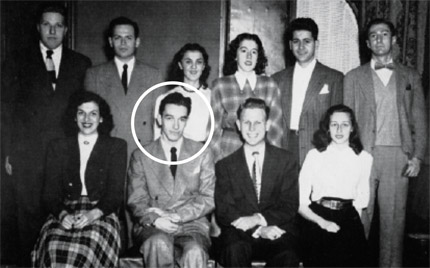memoir
The Scene Makes
the Man
Alan Greenspan remembers tales of jazz, baseball,
and Washington Square
by Ben Birnbaum
In life—as in real estate—location is destiny, and Alan Greenspan’s memoir, The Age of Turbulence: Adventures in a New World (Penguin), makes the case for location in time as well as place. Close proximity to the Polo Grounds—where “kids from the neighborhood could often get in free”—led the future Federal Reserve Board chairman to his earliest use of mathematics to tame chaos: the development of an original scorekeeping system that allowed him to compile and analyze data from the 1936 World Series between the New York Giants and Yankees. He was 10.
 alan Greenspan, once an aspiring jazz musician who played with Stan Getz, co-founded the Symphonic Society, Pictured Here, as an NYU undergrad.
alan Greenspan, once an aspiring jazz musician who played with Stan Getz, co-founded the Symphonic Society, Pictured Here, as an NYU undergrad.
Much of the charm of this memoir—even The Economist called it "an unexpectedly enjoyable read"—lies in such moments that reveal how a great city shaped a great man. Raised by his divorced mother in Washington Heights, then a neighborhood of mostly Jewish middle-class strivers, Greenspan (STERN '48, GSAS '50, STERN '77) was part of a large, raucous family whose members worked on Wall Street and on Broadway, and part of a public school system that challenged the brightest city kids (Henry Kissinger was a high school classmate).
Music was his primary obsession, however, and he studied at Juilliard until he fell in love with jazz. At 15, standing in front of the Glenn Miller bandstand at the Hotel Pennsylvania, he inadvertently yelled out, "That's the Pathétique!" when the band struck up an arrangement of Tchaikovsky's Sixth Symphony. Miller turned toward him and said, "That's terrific, kid." A few years later, sitting in a student saxophone ensemble beside a boy named Stanley Getz, he awoke to the fact that he'd never be a great jazz musician. But he was good enough that when the World War II draft board rejected him (a spot on his lung portended tuberculosis), he was able to land a job playing saxophone in a respectable big band.
The young man playing sax beside him was Lenny Garment, who would later join Greenspan in the Nixon White House. During stage breaks, while most band members enjoyed tobacco or marijuana, Greenspan read library books about business and finance and wondered if he could possibly make a life on Wall Street. In 1945, he followed that question to the School of Commerce, Accounts, and Finance—at the time, "possibly the least prestigious part of NYU," writes Greenspan, who was not a distinguished high school student.
At NYU, he began to believe he had an intellectual calling and developed an interest in econometrics. "I was enthralled by supply-and-demand curves, the idea of market equilibrium, and the evolution of international trade," he remembers. By his junior year, recommended by his statistics professor, he and his slide rule landed a job on Wall Street devising better ways to measure the Fed's seasonal adjustments for department store sales. He would later expand his education by joining author Ayn Rand's objectivist salon, which met regularly in her apartment on East 34th Street to talk and argue the nights away.
Joining together an autobiography and a set of lectures on economics, the memoir (written with the eminent ghost Peter Petre) unfolds with offhand grace. And as much as readers might have enjoyed some self-investigation as sharp as the author's dissections of others (Nixon, he explains, was not "exclusively anti-Semitic" but "hated everybody"), the man in the dark suit—whom Rand nicknamed "the Undertaker"—just isn't a confessional kind of guy. "Not having a dad left a big hole in my life," he writes of his childhood—leaving it at that. But as demonstrated by this spare, rather old-fashioned "life and work" of the most influential American financial planner since the New Deal, the gifts of a valiant mother and city were more than sufficient to fill the void.







